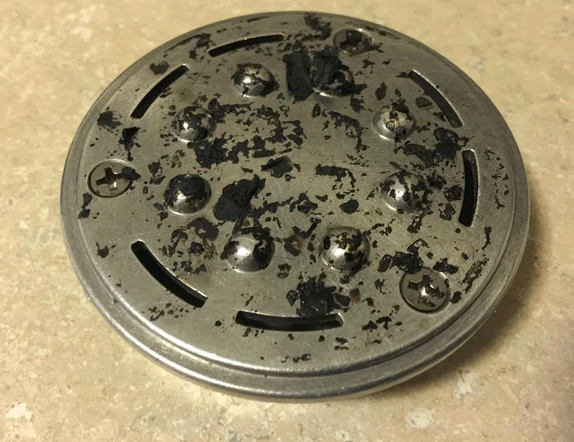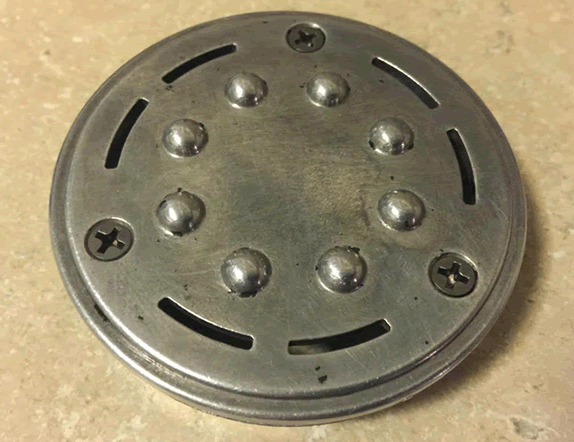For the uninitiated, the Kaloud Lotus is a heat management device that replaces your foil and a wind cover. Built out of some thick, space-age metals, the Lotus excels at providing a uniform, long-lasting hookah smoking experience, often outlasting the tobacco in your bowl.
But it sure does get dirty!

A quick Google or YouTube search will yield you hundreds of results on how to use it – from simple reviews to complete tutorials on using it with a plethora of different hookahs, bowls, and shisha tobaccos.
Finding a tutorial on how to clean it yields some rather interesting results.
While there may be other methods of cleaning the Lotus described out there on the web, here’s my way of going about it. It is abrasive, so just be aware that your Lotus may have some scratches on it after this process, but its performance will not be degraded. You don’t need to clean your Lotus after every session, especially if you pack your tobacco lower, or there’s not much residue on the bottom.
To get started, here’s what is needed, most of which can be found in your kitchen:
- A bowl that can withstand some heat. Ceramic and thick-walled glass cereal bowls will do the trick. Plastics can be used, but probably shouldn’t be used to store food after this process.
- Dish-washing soap. It really doesn’t matter which kind, but something that’s listed as “heavy-duty” will work a little better than a cheaper kind.
- Abrasive steel wool. Nylon “steel wool” won’t be abrasive enough.
- A pair of hookah tongs, or something with a blunt end that you don’t mind getting dirty. Ideally, use a pair of hookah tongs that you don’t normally use for your coals.
Step 1 – Clean Up The Bulk
First off, and I can’t emphasize this enough, let the Lotus cool down! The Lotus gets very hot during use, and singed fingertips don’t make for a fun evening. Once the Lotus is cool, empty it out, and, using the tongs, scrape off as much residue from the bottom of the Lotus as possible. It’s okay if it leaves marks on the finish – the lotus is thick enough that a few scratches aren’t going to damage anything. The goal here is not to remove every burnt-on bit of tobacco and glycerin – just to remove any larger chunks that will easily come off.
Step 2 – The Deep Soak
If you have a hot water pot, boil some water. If not, using your sink, get the hot water running as hot as you can get it.
In the bowl, pour in some dish-washing soap. You don’t need much – a small puddle, about the size of a coin, will be more than plenty.
Fill up the bowl with enough water so that the Lotus can be completely submerged. The water impacting the soap will create lots of bubbles – just push those out of the way to see the water level if you need to.
Next, take your Lotus and cover the bottom (where it’s all gross and nasty) with additional dish-washing soap. It doesn’t need to be a thick layer – you can put just a few drops on, and rub it around with your fingers. You just want the entire bottom of the Lotus covered with soap.
Finally, put your Lotus in the water (bottom-side up), and let it soak. If you want, you can put the top in as well – it gets a lot of soot on it from the coals, but just cleaning that off with a sponge or rag should be fine. Give it at least 30 minutes to soak; an hour would be even better. It’s okay if the water gets cold.
During this time, the hot water activates both the soap and any remaining glycerin/honey that’s on the Lotus. The soapy water will soften up any hardened chunks of tobacco, loosen any un-burned glycerin/honey, and will generally de-grease the Lotus.
Step 3 – The Scrub-Down
After you’ve given it time to soak, it’s time to give the Lotus a good scrub. Pull it out of the water bath and turn on the hot water (about as hot as you would for washing dishes). Give the Lotus a good rinse, and some excess should come off, particularly if it’s really dirty. You can use your hands to push off any residue that might seem loose.
If you’re new to using steel wool, the best technique to making steel wool more abrasive is to try to “pull it apart.” You want to get all of the nice, soft edges (that make it look pretty in the packaging) out, and turn it into a mess of abrasive steel, but you don’t want to actually break the wool. Just keep pulling on it from different directions until it looks rough.
Using the steel wool, scrub the bottom of the Lotus under the hot water. This will scratch the bottom of the Lotus, but, like mentioned above, the Lotus is thick enough that the scratch marks won’t damage it. When you start, it should be easy for a good chunk to come off, but some of the burnt-on tobacco will probably be stubborn. Just continue scrubbing, using additional pressure, directing the steel wool to the areas in need of cleaning. If, after a few minutes of scrubbing, some tobacco just won’t come off, go back to Step 2 and give it another good soak.
Just be aware that the screws on the bottom are one of the most difficult areas to clean. Do the best you can here; because the drive of the screws is inset, getting it perfectly spotless will be nearly impossible, unless you have a little, tiny metal tool that you can scrape it clean with.
Results
Once you’re done, you should have a very clean Lotus, ready to go for your next hookah session. Be sure to dry it very thoroughly. While the Lotus is pretty much rust-proof (except for the top screw, but that can be replaced easily with a trip to the hardware store), water in the Lotus can cause mold (if you’re storing it) or can cause coals to simmer out (if you’re going to smoke another session right away). You may never be able to restore the Kaloud Lotus to its original, shiny glory, but using this technique, you will be able to have a session just as good as the first time you used your Lotus.

Has this article helped you? Do you have a better approach? Share your thoughts in the comments below, or join the friendly hookah enthusiasts over on our forums. We’d love to hear from you.

If you put the heat management on the coal burner, it burns off all the gunk and no scrubbing or time consuming process of deep cleaning is required. Results in all the gunk turning into ash and at the same time my coals are ready as well. Additional tip: I remove the heavy gunk after I am done smoking nonetheless, keep in mind to light the coal burner under an exhaust if you put the HM with gunk on it or in good ventilated area or else the smoke alarm goes off if there is a lot of gunk on the HM.